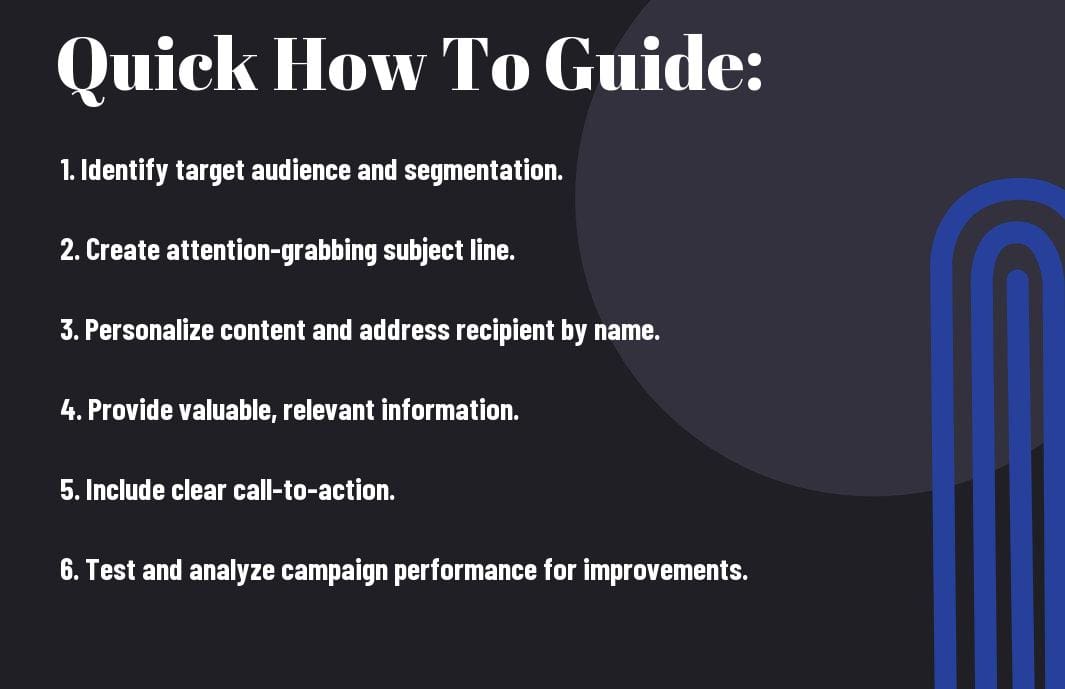There’s no denying the power of email marketing when it comes to reaching your target audience and driving conversions. Crafting engaging email marketing campaigns is vital for any business looking to stand out in a crowded inbox and make a lasting impression on subscribers. In this guide, we’ll walk you through the key steps and strategies to create compelling emails that get noticed and drive results. For further insights on creating successful email marketing campaigns, you can visit How to Create a Successful Email Marketing Campaign.
Key Takeaways:
- Know your audience: Understanding your audience’s preferences, behaviors, and needs is crucial in crafting engaging email content that resonates with them.
- Create compelling subject lines: The subject line is the first thing your audience sees, so make it attention-grabbing and relevant to increase open rates.
- Personalize your emails: Tailoring your emails with personalization techniques such as using the recipient’s name or past purchase history can significantly improve engagement and conversion rates.

Understanding Your Audience
It is crucial to understand your audience when crafting engaging email marketing campaigns. By knowing who your subscribers are and what interests them, you can tailor your content to resonate with them on a personal level.
Identifying Target Demographics
There’s a need to identify the target demographics that make up your email subscriber list. Demographics such as age, gender, location, occupation, and income can provide valuable insights into the interests and needs of your audience. Understanding these factors will help you create content that is relevant and engaging to your subscribers.
Analyzing Subscriber Behaviors and Preferences
Any successful email marketing campaign involves analyzing subscriber behaviors and preferences. By tracking metrics such as open rates, click-through rates, and conversion rates, you can gain a better understanding of what content resonates with your audience. Analyzing subscriber behaviors and preferences will enable you to segment your audience and send targeted content that is more likely to drive engagement and conversions.
Demographics provide a general overview of your audience, while analyzing subscriber behaviors and preferences offers deeper insights into their preferences and actions. By combining these two approaches, you can create email marketing campaigns that are both personalized and compelling to your subscribers.
Crafting the Subject Line
Tips for Writing Compelling Subject Lines
Your email subject line is the first thing your recipients see, so it needs to capture their attention immediately. To craft a compelling subject line, consider the following tips:
- Keep it short and sweet: Aim for 50 characters or less to ensure that the entire subject line is visible on all devices.
- Use action-oriented language: Encourage recipients to take action by using verbs like “Shop now” or “Discover”.
- Personalize when possible: Include the recipient’s name or personalize the subject line based on their past interactions with your brand.
Knowing your audience and what resonates with them is key to writing subject lines that drive open rates and engagement.
Factors Affecting Open Rates
Even the most well-crafted subject line may not be effective if it doesn’t take into account the following factors that influence open rates:
- Relevance to the recipient’s interests or needs
- The sending time and day of the week
- The sender name and reputation
It’s vital to pay attention to these factors to maximize the success of your email marketing campaigns. Any oversight in these areas could result in your emails being overlooked or marked as spam.
Creating Engaging Content
Once again, the key to a successful email marketing campaign lies in creating captivating and compelling content. Your email content should not only grab the reader’s attention but also provide value and relevance to them.
How to Write Relevant and Valuable Content
Valuable content is necessary for engaging email marketing campaigns. Make sure your content is tailored to your target audience and provides them with useful information, discounts, or exclusive offers. Personalize your emails to make the recipient feel special, and always focus on quality over quantity.
Using Visuals to Enhance Engagement
Write visually appealing emails can significantly enhance engagement with your audience. Incorporate eye-catching graphics, videos, and infographics to make your content more engaging and memorable. Visuals can help convey your message more effectively and improve the overall aesthetic of your emails.
Using visuals in your emails can also help break up large chunks of text, making your content easier to digest for recipients. Be sure to optimize your visuals for mobile devices to ensure they are displayed correctly across all platforms.
Personalizing Your Emails
Segmentation Strategies for Personalization
To craft engaging email marketing campaigns, personalization is key. Segmentation strategies allow you to divide your audience into smaller groups based on various criteria such as demographics, behavior, or preferences. By segmenting your email list, you can send targeted messages that are more relevant and resonant with each group’s interests and needs. This can lead to higher open rates, click-through rates, and ultimately, more conversions. Understanding your audience and tailoring your content to fit their specific needs is crucial for successful email marketing.
Implementing Dynamic Content for Better Relevance
To take your personalization efforts to the next level, consider implementing dynamic content in your emails. Dynamic content allows you to show different images, text, or offers to different segments of your audience based on their preferences or past interactions with your brand. This level of customization can significantly increase engagement and drive conversions as it ensures that each recipient receives the most relevant content for them at that specific moment.
While the initial set-up of dynamic content may require more time and resources, the long-term benefits in terms of engagement and ROI make it worth the investment. By utilizing dynamic content, you can deliver highly targeted and personalized emails that stand out in your subscribers’ inboxes, leading to improved email performance and ultimately, a stronger relationship with your audience.
Strategies
Timing and Frequency
Finding the Right Time to Send Emails
All successful email marketing campaigns have one thing in common – the right timing. As an email marketer, it’s crucial to understand your target audience’s behavior and preferences to determine the best time to send emails. You can use data analytics tools to track open rates at different times of the day and days of the week to identify patterns. Once you have gathered enough data, you can schedule your emails to be sent when your subscribers are most likely to engage with them.
How Often to Contact Your Subscribers
Even with the right timing, bombarding your subscribers with too many emails can lead to unsubscribes and loss of interest. It’s crucial to strike a balance between staying top of mind and overwhelming your audience. Consider the nature of your business and the expectations of your subscribers when determining how often to contact them. A weekly newsletter might work well for some industries, while others might find that a bi-weekly or monthly schedule is more effective.
Even though consistency is key in email marketing, it’s also important to be flexible and responsive to your subscribers’ engagement levels and feedback. Monitor your email metrics regularly and adjust your frequency as needed to ensure that you are providing value without becoming a nuisance.
Testing and Optimization
Despite the importance of crafting captivating email content, testing and optimization are equally crucial aspects of running successful email marketing campaigns. Continuous improvement is important to keep up with the ever-evolving preferences and behaviors of your audience. To enhance your understanding of testing and optimization in email marketing, explore 15 ways to improve your email marketing campaigns.
The How-To of A/B Testing
Now, let’s probe into A/B testing, a powerful tool to gauge the effectiveness of different elements in your emails. By creating two variations of a single campaign element and sending them to segmented portions of your subscriber list, you can analyze which version performs better based on predefined metrics. Elements to test include subject lines, call-to-action buttons, images, and overall layout. Through A/B testing, you can refine your email content based on real data, ensuring optimal engagement with your audience.
Analyzing Data to Improve Future Campaigns
Clearly, analyzing data plays a pivotal role in shaping the success of your future email marketing campaigns. By scrutinizing metrics such as open rates, click-through rates, conversion rates, and subscriber behavior, you can gain valuable insights into what resonates with your audience. This data-driven approach enables you to identify trends, preferences, and areas for improvement to continually enhance your email strategies. Leveraging analytical tools and interpreting data accurately empowers you to make informed decisions and tailor your campaigns for maximum impact.
Future
When analyzing data to improve future campaigns, it’s crucial to pay attention to patterns and outliers that emerge from your metrics. Identifying consistent trends can guide your content creation and segmentation strategies, while addressing anomalies can help you troubleshoot and optimize your campaigns. By staying proactive in refining your email marketing efforts through data analysis, you can adapt to your audience’s needs and preferences, ultimately driving better results and engagement.
Legal Compliance and Best Practices
Ensuring Your Campaigns are GDPR Compliant
After the implementation of the General Data Protection Regulation (GDPR), it is crucial for email marketers to prioritize data protection and privacy. GDPR compliance is non-negotiable when crafting email marketing campaigns. This regulation requires that companies obtain explicit consent from individuals before sending them marketing emails, ensuring transparent data practices, and providing an easy opt-out option for recipients.
Maintaining Subscriber Trust and Deliverability
On the journey to building successful email marketing campaigns, maintaining subscriber trust and deliverability should be at the forefront of your strategy. A high level of trust with your subscribers not only improves engagement rates but also contributes to better deliverability. Subscriber trust can be built by sending relevant content, honoring subscriber preferences, and being consistent in your email communication.
With Maintaining Subscriber Trust and Deliverability
GDPR compliance is not just about legal obligations; it’s also about building a positive reputation with your audience. By ensuring that your email marketing campaigns are GDPR compliant, you are conveying to your subscribers that you value their privacy and are committed to maintaining their trust. This trust will not only enhance your brand reputation but also boost your email deliverability rates, leading to more effective campaigns and increased ROI.
To wrap up
Taking this into account, crafting engaging email marketing campaigns requires understanding your audience, creating compelling content, optimizing for mobile devices, and focusing on personalization. By utilizing these strategies, businesses can effectively connect with their customers, drive engagement, and ultimately improve their ROI.
Remember to continuously analyze your email performance metrics, A/B test your campaigns, and stay updated on industry best practices to ensure the success of your email marketing efforts. With strategic planning and a customer-centric approach, you can create email campaigns that resonate with your audience and drive results for your business.
FAQ
Q: Why is crafting engaging email marketing campaigns important?
A: Crafting engaging email marketing campaigns is important because it helps businesses connect with their audience, drive conversions, and build brand loyalty.
Q: What are the key components of a successful email marketing campaign?
A: The key components of a successful email marketing campaign include a compelling subject line, personalized content, clear call-to-action, mobile optimization, and analytics for tracking performance.
Q: How can I personalize my email marketing campaigns?
A: Personalize your email marketing campaigns by segmenting your audience based on their preferences, behavior, and demographics. Use dynamic content and merge tags to address recipients by their name for a more personalized touch.
Q: What are some best practices for writing email subject lines?
A: Some best practices for writing email subject lines include keeping them concise, creating a sense of urgency or curiosity, avoiding spam triggers like all caps or exclamation points, and testing different variations to see what works best.
Q: How do I create a strong call-to-action in my emails?
A: To create a strong call-to-action in your emails, use clear and action-oriented language, make it visually stand out with buttons or different colors, create a sense of urgency, and ensure it is relevant to the content of the email.
Q: What is A/B testing and why is it important for email marketing campaigns?
A: A/B testing is a method where two versions of an email are compared to see which one performs better. It is important for email marketing campaigns because it helps optimize content, subject lines, and designs based on real data and insights.
Q: How can I measure the success of my email marketing campaigns?
A: You can measure the success of your email marketing campaigns by tracking metrics such as open rates, click-through rates, conversion rates, bounce rates, and unsubscribe rates. Use these metrics to analyze performance and make data-driven decisions for future campaigns.




